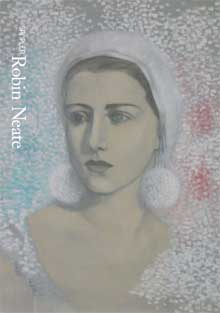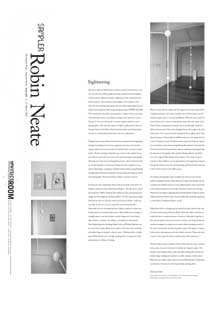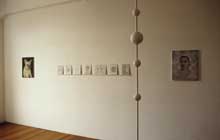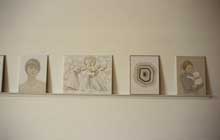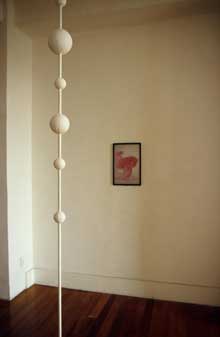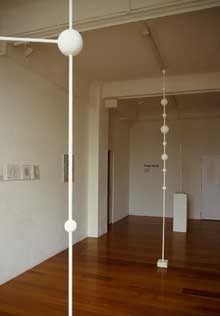 |
|||||||||
|
|
| ...GALLERY EXHIBITS 2004 | ...Sightseeing | ||||||||||||||||
|
Erected in 1889, the Eiffel Tower aroused a tumult of controversy, as any civic artwork does, before quickly becoming assimilated into the skyline of Paris and the collective romantic imagination of the world’s dreamers. Social reaction to the monuments and imagery of art changes so fast, what was once shocking and jarring to the eye, within a generation becomes sedated with familiarity. After closing during the years of WWII, the Eiffel Tower reopened to the public attracting about a million visitors a year from 1946, although tourism was perhaps not high on the agenda of many in Europe for the rest of the decade. A tourist snapshot taken by a street photographer in the early ‘50s depicts a couple casually posed in front of the great Tower. Artist Robin Neate found this black and white passport size shot in a Christchurch junk shop in the next millennium. Taking the photo home, Neate continued his own cultural tourism, sightseeing through the backlog of art history, magazines and some of the familiar imagery rejected by the commercial and stylistic forces of current popular culture. Neate’s paintings in this show are a return to the medium for an artist who has spent the recent years of his career focusing on photography. Although you could say his photographic practice, which revolved around an anti-photographic re-shooting of images beyond recognition, was in essence still painting - zooming in on details of source photos and reproducing enlarged pieces that become abstracted and stop doing the things we expect from photographs, like documenting a reality or narrative moment. For this new suite of paintings, Neate took up the brush in the spirit of a hobbyist, using pre-made canvas boards (Fredrix - "Serving artists around the world since 1886"), working with washed out oils, and painting from images found in magazines. Starting small (6" x 8") and using source images that have become over the past century art historical clichés - ballerinas, a poodle, the face of a woman, a girl with cat, abstracted doodles - Neate takes his turn at attempting these subjects common to almost any Sunday painter. A restrained palette gives these subtle pieces a feeling of nostalgic glances over the shoulder to all the things we’ve loved before (like whiskers on kittens). An affinity to a handful of contemporary New Zealand painters including Saskia Leek and Michael Harrison can be seen in these works. Harrison has spoken of his own work as looking at familiar things as though for the first time. 1 Working within a similar genre, Robin Neate’s more nostalgic paintings have an expression of the culmination of a lifetime of looking. Wary of art that fits too closely into the category of the latest trend, Neate is happier looking at those styles and ideas once widely popular, now left behind yet again open to renewed possibilities. With three lean sculptural pieces, Neate struts a series of white plaster works down the center of the Physics Room contemporary art project space, echoing high modernist Alberto Giacommetti. These three elongated forms, tall enough in the scale of this space to be monumental, flex and fade white on gallery white. The physical presence of these polemic bubbled works has to be negotiated, but a sense of fragility remains. Worked up from original drawings, the objects have a sketchiness about them, thoughtful doodles rendered 3-dimensional. Unforced visual motifs repeated from object to painting to photograph help the elements to sit together, with a gently unifying aesthetic and subtle tone. The original 1950s Parisian tourist photo is the closest we get to narrative in this exhibition. It sits appropriately at the beginning, enlarged through the artist’s process of re-photographing, and framed by the doorway it faces at the entrance to the gallery space. Two further photographic works complete the mise-en-scene for this untitled sampling of works. These shots are of vague and indistinct forms, rounded as the bulbous portions of the sculptural pieces, fuzzy and muted as the abstracted painting of a poodle. All sense of scale is lost through Neate’s lens, tiny objects (originally pink and white plastic Christmas cracker trinkets) pushed to fill the frame become indefinable and playful, appearing as some kind of ambiguous balloon animal. Exhibiting within a contemporary art world that often seems to talk only in ironies and knowing witticisms, Robin Neate here offers a selection of works that have a complete absence of cynicism. Although a huge fan of film and having had various involvement in fashion and design, Neate has somehow managed to conduct an art career without showing concern to the "now" and obsessive newness of popular culture. The impetus of theory behind much contemporary art is also of little concern to Neate, who feels it may be "time again for artists to address poets before professors." 2 With his Physics Room exhibition, Robin Neate gives the viewer optional entry points, chances to look back to familiar but forgotten sights. This selection and mixing of ideas, media and styles, with gentle restraint and modest image-making, has resulted in a subtly resonant, timeless show. While the city of Paris makes a bid to host the 2012 Olympics, Neate helps us look back in the process of moving forward, starting afresh. Rosemary Forde 1 Michael Harrison in reference to his 2003 exhibition at the Dunedin Public Art Gallery. 2 Robin Neate in conversation with the writer, March 2004. View Sightseeing - Essay by Rosemary Forde as a PDF
|
||||||||||||||||

